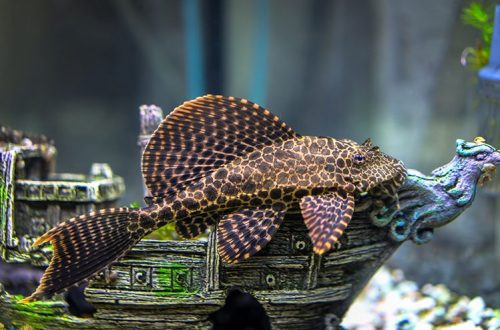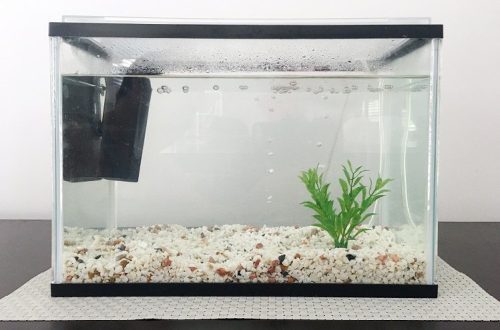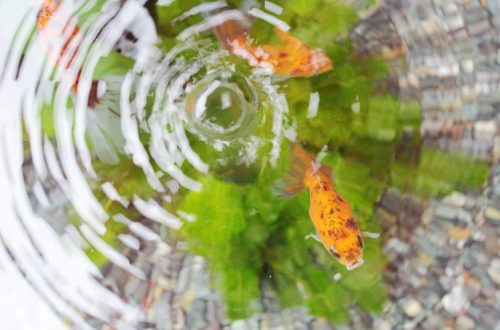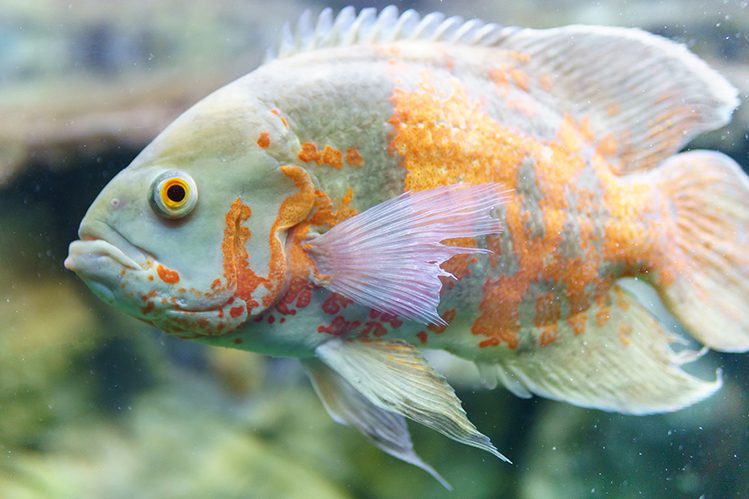
Astronotus: a popular fish with character
You probably remember the amazing impression that the first aquarium you saw with astronotus made on you. Large, harmoniously built unhurried fish fascinate with the beauty of movements, huge eyes and spectacular color. But for the astronotus lover, keeping and caring for these aquarium fish can turn into a number of difficulties. Let’s talk about why everyone loves these amazing creatures and why not every aquarist manages to find a common language with them.
Underwater intelligence
The Astronotus fish is native to the rivers of South America, where these members of the cichlid family usually grow up to 40 centimeters. Astronotus are distinguished by high intelligence. Astronotus in the aquarium quickly get used to the owner, become attached to him. It sounds incredible, but the fish really distinguish the owner among the household and swim closer when they see that their dear breadwinner has come to the aquarium to see if his wards are doing well.
Astronotus owners note that fish can be taught to carefully take food from their hands, although if the pets are very hungry, they can bite their fingers painfully. Some owners of these fish say that astronotus are somewhat reminiscent of cats in their behavior: they let the owner stroke them, they watch with intelligent eyes what family members are doing, what is happening in the house. Astronotus memorize what time they are being fed and may start wagging their tails and opening their mouths to indicate that it is dinner time. One aquarist told like-minded people on the network that she and her husband had an astronotus that would start a storm of activity in the aquarium and wake them up at the same hour on weekends, fearing that the owners’ alarm did not go off. Some owners of the aquarium intellectual joke that they sometimes feel uncomfortable because the astronotus looks at them like it understands everything.
These smart fish live from 10 to 18 years. For the longevity of Astronotus, proper maintenance and care are of key importance. Take care of your ward, and the astronotus will become a true friend for many years to come.
Special mention should be made of the beautiful color of astronotus. There are an incredible variety of color varieties of these fish, you can choose the most exotic to your taste. The most popular gray-black-red natural color, copper color and albino astronotus.

Special conditions
Astronotus food is a hot topic. These fish eat a lot, even a lot, they are prone to overeating. Once a week it is worth arranging a fasting day for them. It is best to make the basis of the diet a special food for cichlids of the largest fraction – sticks or puck tablets. It is important that the fish eat their food completely. All uneaten food should be immediately removed from the aquarium so that food remains do not pollute the water.
How to feed astronotus to diversify their diet? Fish fillets will do, as well as small live fish that you purchased from a safe place and quarantined in a separate aquarium. If the idea of feeding live fish is not to your liking, you can raise food crickets or other food insects at home. Some owners admit that they feed insects to astronotus that have flown into their house. It is not necessary to do so. It is not clear where these insects managed to fly; with them, dangerous bacteria and parasites can be brought into the aquarium. This is especially true of cockroaches, which can even come running from their neighbors poisoned.
Astronotus loves to eat well and tasty, and therefore goes to the toilet quite plentifully. Therefore, an aquarium is needed with a very powerful filtration. In addition to the internal filter, fish owners are advised to consider installing an external filter or sump, which makes it possible to purify the water in several stages.
We emphasize that all equipment must be protected, masked, hidden from astronotus. Otherwise, the fish will definitely become interested in technology, and the matter may even end with an electric shock. An aquarium with energetic astronotus must be equipped with a lid, otherwise frolicking fish will spray the entire floor or even accidentally jump out of the aquarium.
The water parameters for Astronotus are similar to those preferred by all cichlids. The water temperature is from 22 to 28 degrees, but it is better to stop at 25 degrees and maintain a stable temperature regime. Astronotus are suitable for water acidity from 6,5 to 7,5, water hardness – up to 25. It is extremely important not to allow an increased content of nitrogenous compounds, to control water quality using drop tests.
One of the most important requirements for the maintenance of astronotus is a large volume of the aquarium. Two adults need at least 250 liters in which only the two of them will swim. And even better – 500 liters, so that there is where to turn around. Five of these Astronotus fry can be settled in a hundred liters, but they will grow up so quickly that you will not have time to look back, when the time comes to purchase an aquarium of very impressive dimensions.
Do not follow the example of aquarists who post videos with a company of six to eight Astronotus in a 250-liter aquarium and say that the fish do well in such conditions. It is unlikely that the astronotus themselves told them about their well-being, moreover, the fish in such a situation have no choice. Do not force pets to live in a closet, make sure that they have their own space.
If you want your astronotuses to form a loving couple, this is where things get tricky. Even an experienced aquarist cannot accurately distinguish a female Astronotus from a male. The differences between them become visible during the spawning period (you will have to wait until the fish are one and a half to two years old). In general, the features of the female are smoother and more rounded, while the fins and body of the male are more pointed. And if the male and female have been living together in the same aquarium since they were fry, the female will be slightly smaller in size.
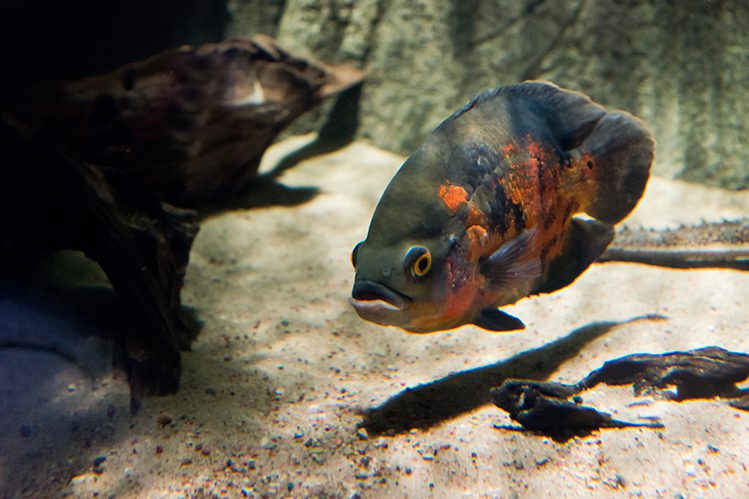
Glory to the quarrelsome neighbor
Astronotus love creative mess in the aquarium. They move small snags, dig the soil, tear it out of the soil, or eat aquarium plants. They arrange a rearrangement in the aquadome every day. The most harmless version of the underwater landscape in an aquarium with astronotus is one or two very large and heavy snags, several heavy stones without sharp edges, and very fine sand with a layer of one or two centimeters as soil.
Astronotus are territorial and highly aggressive fish, like all cichlids. We repeat that it is better to make a choice in favor of a species aquarium with one or two astronotus. These fish are not just predators, they are nocturnal hunters. Even if the astronotus behaves civilly during the day, under the cover of night it can easily eat any small fish if it fits in its mouth. The only salvation for small fish is to hide in grottoes, snags and other decorations where astronotus cannot reach them.
However, there are neighbors with whom the astronotus can live relatively friendly. These are other cichlids and catfish, provided that their size is comparable to the dimensions of the astronotus, that they can stand up for themselves and will not chase the astronotus themselves. If the astronotus is supposed to have neighbors, then it does not need to be settled in the aquarium first, otherwise it will declare the entire aquadom its territory and will not give life to all new arrivals.
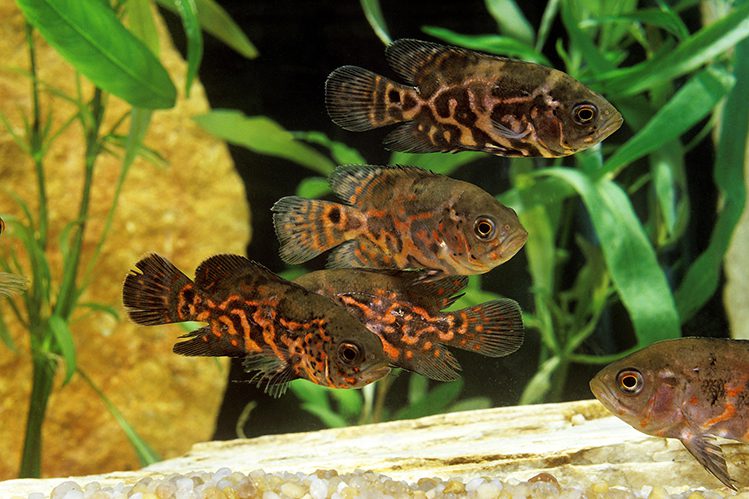
In conclusion, we say that in order to provide the necessary conditions for astronotus in an aquarium, you need to have some experience in aquarism. A true fan of astronotuses will not be prevented from getting these fish. But besides the dictates of the heart, informational preparation, the presence of a spacious aqua house and the necessary equipment are also important.
We wish your astronotus to live long, be happy and healthy.



